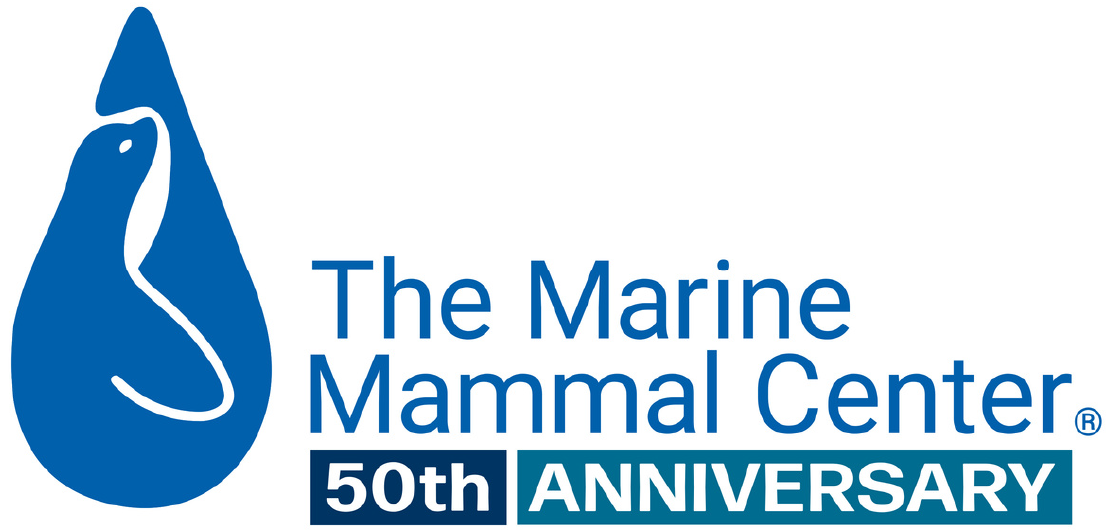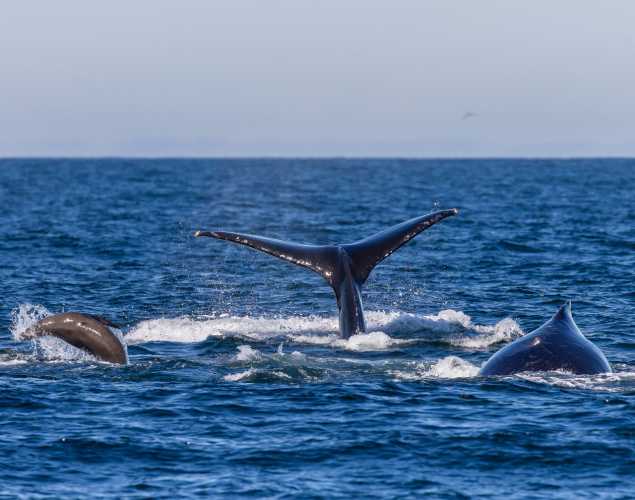
What is the Loudest Animal on Earth? And Other Animal Trivia
- Behavior
- Species conservation
- Leptospirosis
- Natural history
How well do you know your marine mammal facts? From the loudest species in the animal kingdom to the furriest, test your knowledge with this animal trivia. Plus, learn about critical efforts to protect marine mammals and create a healthy ocean.
Ready to dive in? Click “Show More+” to reveal the answer and more fascinating animal facts.
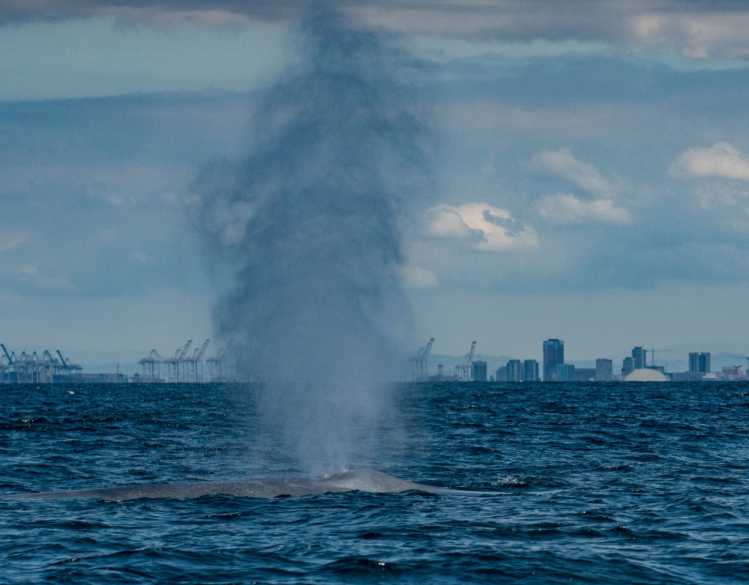
What is the loudest animal on Earth?
Blue whales and sperm whales are among the loudest animals in the world. Sperm whales can produce a series of echolocation clicks of more than 200 decibels (the measurement unit for the intensity of sound). And as blue whales vocalize their rumbling songs of more than 180 decibels, they can produce the loudest sustained sound of any animal. Put into perspective, the piercing sound of a jet engine is about 140 decibels!
In the right ocean conditions, blue whale vocalizations can be heard by other whales up to 1,000 miles away. Unfortunately, ocean noise pollution from ships and other human activity poses a major threat to whales, altering their ability to communicate and find other whales. As these animals’ paths increasingly intersect with high-traffic shipping routes, ship strikes have also become a leading cause of death for large whales on the California coast, and particularly those entering San Francisco Bay.
The Marine Mammal Center’s researchers are conducting scientific studies to monitor whales and find solutions. In collaboration with the Benioff Ocean Science Laboratory, we deployed Whale Safe, an AI-powered system that monitors blue, fin and humpback whale vocalizations and other data to inform ships when whales are present. Ships that slow down in whale habitats can prevent deadly collisions while also reducing ocean noise, carbon emissions and other harmful environmental impacts.
Do marine mammals drink water?
Marine mammals generally do not need to drink water, as their bodies are very efficient at removing and recycling water from the prey they eat. While some animals like sea otters are known to drink seawater on occasion, marine mammals primarily get the hydration they need from their food sources.
However, symptoms of sick marine mammals sometimes include drinking water. When an animal is infected with leptospirosis, for example, their kidneys stop functioning properly and cannot filter toxins or regulate hydration. The Center’s veterinary experts can usually identify leptospirosis in a sick California sea lion even before laboratory tests confirm a diagnosis because of the infection's distinctive symptoms, which include drinking water and folding the flippers over the abdomen.
As the world’s largest marine mammal hospital, the Center is at the forefront of research on diseases in marine mammals like leptospirosis. What our scientists learn from treating patients helps us improve our rehabilitative care, better understand how diseases are transmitted, and protect human and animal health.


How many hairs per square inch does a sea otter have?
With nearly 1 million hairs per square inch, sea otters have the densest fur of any animal on Earth.
Why do sea otters need so much fur? Without blubber to protect them in the chilly ocean, they rely on this adaptation to keep warm and survive. In fact, sea otters have two layers of hair that trap air and keep their skin dry. But their fur loses its insulating qualities if exposed to oil, putting them at risk of oil spills. As part of the Oiled Wildlife Care Network, the Center acts as a primary response facility during a large spill to make second chances possible.
Other threats sea otters face include infectious diseases, shark bites, maternal separation, boat strikes and entanglement. Thanks to caring people like you, our experts are conducting research and providing life-saving treatments to threatened southern sea otters.
As a keystone species, sea otters are essential to a healthy ecosystem. Helping this threatened species to recover can have a ripple effect restoring critical environments and strengthening our natural defenses against climate change.
Yes, I want to save a life!
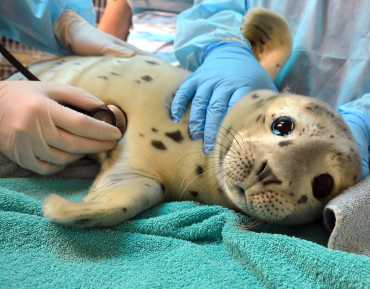
Yes, I want to save a life!
You’ll be giving sick and injured animals the best possible care at the Center’s state-of-the-art hospital. With your gift today, you are giving a patient a second chance at life in the wild.
See Our Latest News
{"image":"\/Animals\/Patients\/Harbor seals\/2020\/cropped-images\/hs-barnwood-by-bill-hunnewell-c-the-marine-mammal-center-315-0-3299-2577-1607370547.jpg","alt":"harbor seal Barnwood","title":"Last-Minute Gift Guide \u2013 Top Gifts that Give Back to Marine Animals","link_url":"https:\/\/www.marinemammalcenter.org\/news\/last-minute-gift-guide","label":"News Update","date":"2025-12-18 01:00:00"}
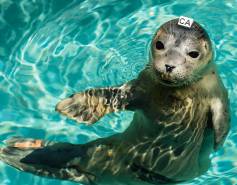
Last-Minute Gift Guide – Top Gifts that Give Back to Marine Animals
December 18, 2025
Read More{"image":"\/Animals\/Patients\/Hawaiian monk seals\/2025\/cropped-images\/b-ru72admission-to-ke-kai-ola112125photo-c-the-marine-mammal-center-noaa-permit-24359-0-364-1270-992-1766095407.jpg","alt":"A newborn Hawaiian monk seal pup with a black coat in rehabilitative care.","title":"Newborn Hawaiian Monk Seal Pup Now Receiving Care","link_url":"https:\/\/www.marinemammalcenter.org\/news\/newborn-hawaiian-monk-seal-pup-now-receiving-care","label":"Patient Update","date":"2025-12-18 01:00:00"}

{"image":"\/Animals\/Patients\/Hawaiian monk seals\/2025\/cropped-images\/d-ru28release-exam-at-ke-kai-ola111025photo-by-giancarlo-rulli-c-the-marine-mammal-center-noaa-permit-24359-0-0-1270-992-1764620886.jpg","alt":"","title":"Bird Flu Vaccine Trial Offers Hope for Protecting Hawaiian Monk Seals","link_url":"https:\/\/www.marinemammalcenter.org\/news\/bird-flu-vaccine-trial-may-offer-hope-for-protecting-hawaiian-monk-seals","label":"News Update","date":"2025-12-01 08:13:00"}

Bird Flu Vaccine Trial Offers Hope for Protecting Hawaiian Monk Seals
December 1, 2025
Read More{"image":"\/Animals\/Patients\/Hawaiian monk seals\/2021\/hms-pp08-by-sheila-latta-c-the-marine-mammal-center-noaa-permit-18786.jpg","alt":"Hawaiian monk seal","title":"The New York Times: Inside the Bird-Flu Vaccine Trial for Monk Seals","link_url":"https:\/\/www.marinemammalcenter.org\/news\/the-new-york-times-inside-the-bird-flu-vaccine-trial-for-monk-seals","label":"In the News","date":"2025-12-01 01:00:00"}

The New York Times: Inside the Bird-Flu Vaccine Trial for Monk Seals
December 1, 2025
Read More